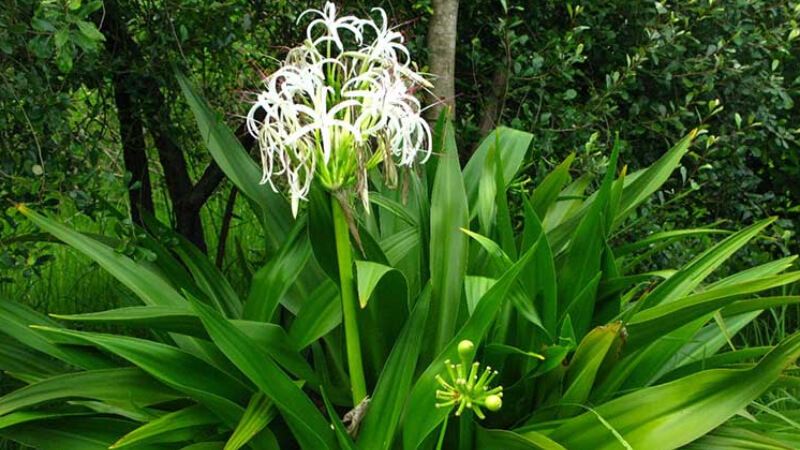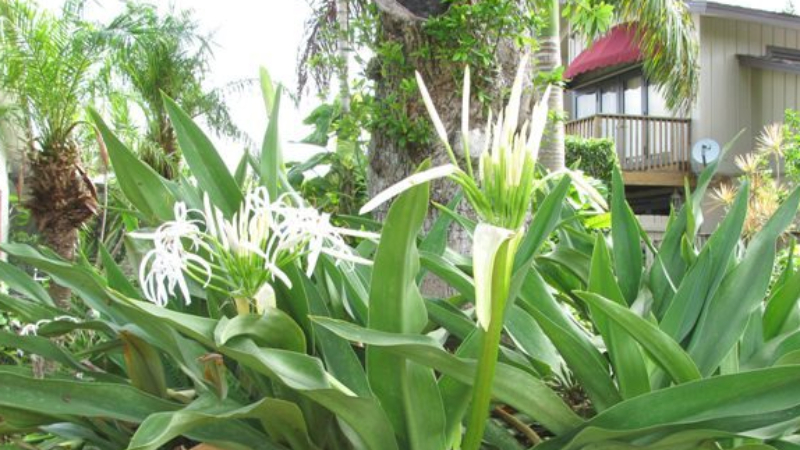The Crinum asiaticum L., or the General’s Tree, is more than just an ornamental plant. This remarkable species offers a myriad of benefits to human health and well-being, making it a valuable addition to any environment. Let’s delve deeper into the wonders of this tree and explore its significance.
1 Unveiling the General’s Tree
 The General’s Tree, scientifically known as Crinum asiaticum L., belongs to the Amaryllidaceae family.
The General’s Tree, scientifically known as Crinum asiaticum L., belongs to the Amaryllidaceae family.
Names and Origins
The General’s Tree, with its scientific name Crinum asiaticum L., is also affectionately called by various names such as elephant garlic tree, water banana tree, and náng tree. Native to the Americas, it was first discovered in India, Indonesia, and the Mollucan Islands, eventually making its way to Vietnam during the French colonial period.
In Vietnam, the General’s Tree thrives near rivers, streams, ponds, and canals, favoring damp soil and a cool climate. Its versatile nature also lends itself to medicinal and ornamental purposes.
Physical Characteristics
The General’s Tree boasts a cylindrical trunk and a soft, herbaceous nature. It typically grows to a height of 1 to 1.5 meters. Its leaves are shaped like lances, reaching up to a meter in length. They evolve from a lush green in their youth to a deeper shade of green as they mature, growing in layers and concentrating near the top of the bulb.
The tree’s flowers are its crowning glory, showcasing a striking combination of white and red. Blooming between March and July, these flowers grow in large clusters on a long stem, about 60 centimeters in length. Each flower boasts five to six petals, exuding a delightful fragrance. However, their beauty is fleeting, as they wilt within two to three days.
As the flowers wither, the flower stalk swells to form fruits of varying sizes, mostly spherical and pale green.
2 The Multifaceted Benefits of the General’s Tree
 The General’s Tree offers a range of benefits.
The General’s Tree offers a range of benefits.
Every part of the General’s Tree, from its flowers and leaves to its trunk and roots, holds medicinal value. This is attributed to the presence of beneficial chemicals within each component, such as Crinamin and Ambelin in the flowers, and Lycorin and Crinamin in the fruits. These substances have been utilized in herbal medicine to support human health in numerous ways.
The tree is particularly renowned for its ability to alleviate ailments such as:
- Joint pain
- Bruises and blood stasis
- Sore throat
- Chronic back pain
- Skin conditions like acne and itching
3 The General’s Tree in Feng Shui
 The General’s Tree holds significance in Feng Shui.
The General’s Tree holds significance in Feng Shui.
In the realm of Feng Shui, the General’s Tree lives up to its majestic name. It is believed to guard and bring peace to its owners, just as a general would. According to ancient beliefs, the blooming of the General’s Tree signifies happiness and tranquility. Thus, it is often placed in the center of a room or near the entrance of a home to maximize its positive influence.
Additionally, the fragrant flowers of the General’s Tree create a calming atmosphere, promoting relaxation and purifying the air. This, in turn, fosters a sense of well-being and inspiration for those who encounter it, setting a positive tone for the day ahead.
4 Cultivating and Caring for the General’s Tree
 Learn how to grow and care for the General’s Tree.
Learn how to grow and care for the General’s Tree.
Planting Season: The General’s Tree flourishes in the summer when the weather is cool and pleasant. Therefore, the ideal time to plant it is during late winter or early spring, or during the rainy season, when humidity is higher, facilitating its growth.
Light: The General’s Tree thrives in sunny and humid conditions. If grown indoors, ensure it receives ample sunlight and regular watering.
Temperature: This resilient tree tolerates a wide range of temperatures, from 25 to 30 degrees Celsius, making it adaptable to various regions. However, extreme heat or cold may hinder its flowering and overall development.
Soil: While the General’s Tree is relatively low-maintenance and adaptable to different soil types, it is crucial to plant it in well-aerated, loose soil to prevent root rot and ensure sufficient oxygen supply for the roots.
Planting Hole: For optimal growth, prepare the planting hole with dimensions of 50x50x50 centimeters and enrich the soil with compost or fertilizer.
Seedling Selection: Choose robust seedlings with thick stems and intact root balls. Healthy leaves are also a good indicator of the seedling’s vitality.
Watering: Young trees require ample water for their initial growth. Maintain a consistent moisture level by watering two to three times a week, increasing the frequency during dry spells.
Fertilization: There is no need to over-fertilize the General’s Tree. A light application of fertilizer before flowering is sufficient. Use NPK fertilizer or well-rotted manure to encourage growth, and consider adding potassium fertilizer when the tree is in bloom to prolong the flower’s life.
The General’s Tree is naturally resistant to pests and diseases. In the rare case of leaf-eating insects, simply remove the affected leaves to prevent further damage.
We hope that this comprehensive guide has enlightened you about the General’s Tree and its multifaceted significance. Incorporate this versatile tree into your life and experience its benefits firsthand. Wishing you good health and happiness!
2023 Lunar New Year Gift Ideas for Older Family and Friends
As 2021 approaches, families worldwide are gathering to celebrate the special bond between grandparents and their grandchildren. To show their love and admiration, these thoughtfully chosen gifts will bring a smile to the face of the elderly. Here, we have compiled a list of the 13 most meaningful Tet presents that can bring joy to our beloved grandparents.






































